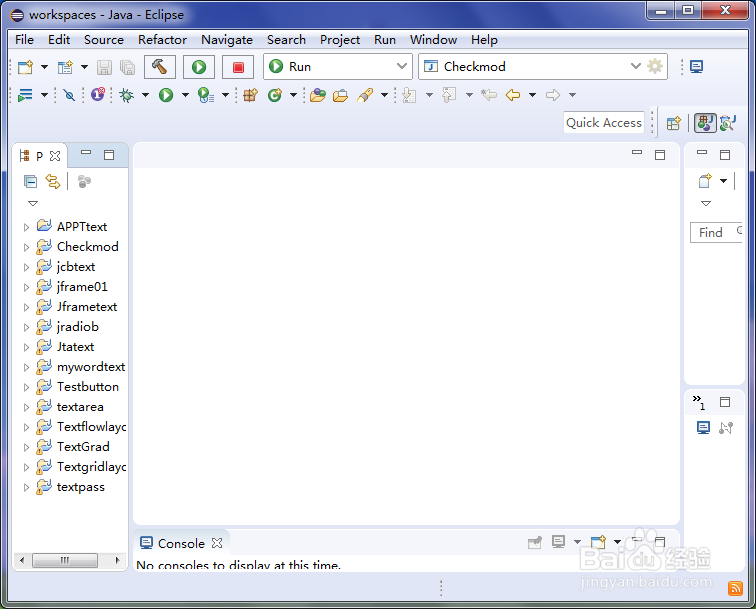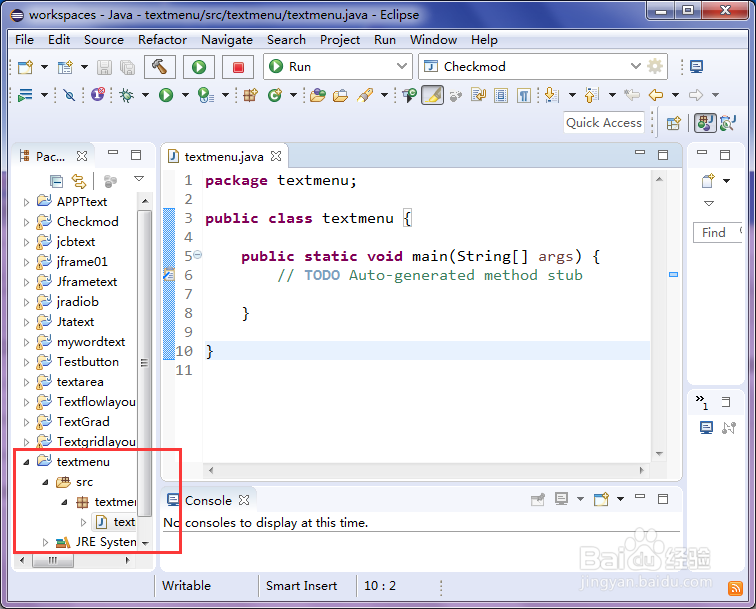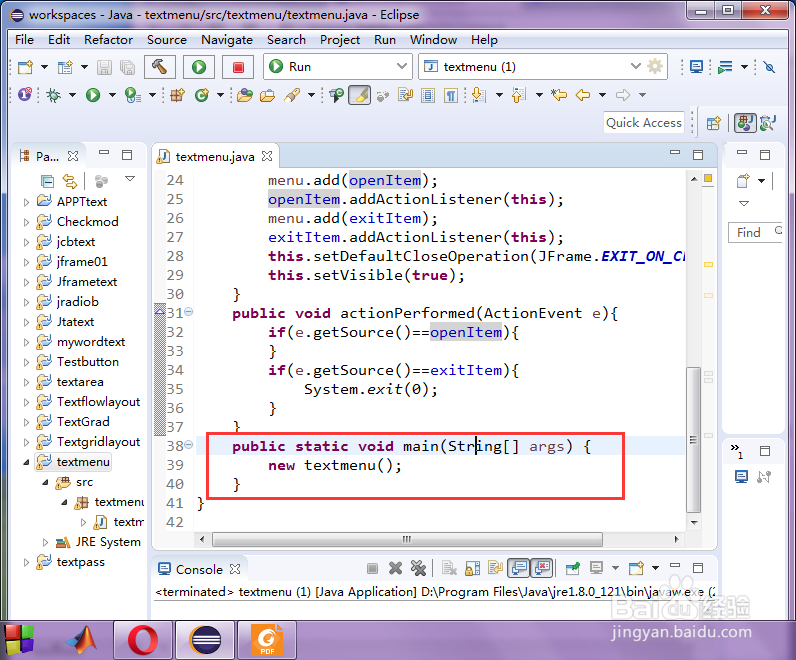eclipse建立java窗口上的菜单栏
1、1.打开ied
也就是打开自己的eclipse软件,当然也可以使用不同的IED,第一步就是打开它。

2、2.建立一个java工程
建立工程,是编写一个java项目的第一步,相信大家刚开始学习java的时候都已经会了吧。

1、1.主类模型
经分析,主类需要建立一个窗口类;需要有面板,按钮,菜单栏,菜单项等对象;同时,还需要事件处理类;构造方法、事件处理方法、main方法;具体代码如下:
package textmenu;
import java.awt.event.ActionEvent;
import java.awt.event.ActionListener;
import javax.swing.JFrame;
import javax.swing.JLabel;
import javax.swing.JMenu;
import javax.swing.JMenuBar;
import javax.swing.JMenuItem;
public class textmenu extends JFrame implements ActionListener{
private static final int DEFAULT_WIDTH=300;
private static final int DEFAULT_HEIGHT=300;
private JLabel label=new JLabel();
private JMenuItem openItem =new JMenuItem("打开");
private JMenuItem exitItem =new JMenuItem("关闭");
public textmenu(){
}
public void actionPerformed(ActionEvent e){
}
public static void main(String[] args) {
}
}

2、2.建立构造方法
所谓构造方法就是实现对象实例化的一个方法,用于对实例化的对象进行初始化处理;代码如下:
public textmenu(){
setTitle("看图片");
setSize(DEFAULT_WIDTH, DEFAULT_HEIGHT);
add(label);
JMenuBar menuBar=new JMenuBar();
setJMenuBar(menuBar);
JMenu menu=new JMenu("文件");
menuBar.add(menu);
menu.add(openItem);
openItem.addActionListener(this);
menu.add(exitItem);
exitItem.addActionListener(this);
this.setDefaultCloseOperation(JFrame.EXIT_ON_CLOSE);
this.setVisible(true);
}

3、3.事件处理方法
鼠标每动一次就会触发一个事件,该方法就是这个事件进行相关的相应,本实例的代码如下:
public void actionPerformed(ActionEvent e){
if(e.getSource()==openItem){
}
if(e.getSource()==exitItem){
System.exit(0);
}
}

4、4.建立main方法
对于所有的java工程或是类,main方法都是程序执行的入口,若没有则无法运行。代码如下:
public static void main(String[] args) {
new textmenu();
}

1、1.编译运行
和其他的java工程一样,单击“编译运行”按钮,或是通过菜单栏中找到这个命令就可以了,会出现初始化以后的界面。

2、2.操作验证
我们尝试一下对菜单栏进行选择,试试。

3、3总结:
本工程的全部代码粘贴如下:
package textmenu;
import java.awt.event.ActionEvent;
import java.awt.event.ActionListener;
import javax.swing.JFrame;
import javax.swing.JLabel;
import javax.swing.JMenu;
import javax.swing.JMenuBar;
import javax.swing.JMenuItem;
public class textmenu extends JFrame implements ActionListener{
private static final int DEFAULT_WIDTH=300;
private static final int DEFAULT_HEIGHT=300;
private JLabel label=new JLabel();
private JMenuItem openItem =new JMenuItem("打开");
private JMenuItem exitItem =new JMenuItem("关闭");
public textmenu(){
setTitle("看图片");
setSize(DEFAULT_WIDTH, DEFAULT_HEIGHT);
add(label);
JMenuBar menuBar=new JMenuBar();
setJMenuBar(menuBar);
JMenu menu=new JMenu("文件");
menuBar.add(menu);
menu.add(openItem);
openItem.addActionListener(this);
menu.add(exitItem);
exitItem.addActionListener(this);
this.setDefaultCloseOperation(JFrame.EXIT_ON_CLOSE);
this.setVisible(true);
}
public void actionPerformed(ActionEvent e){
if(e.getSource()==openItem){
}
if(e.getSource()==exitItem){
System.exit(0);
}
}
public static void main(String[] args) {
new textmenu();
}
}